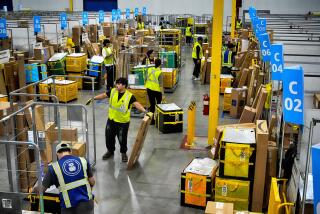Third-quarter GDP growth is revised higher but weakness looms
- Share via
WASHINGTON -- The U.S. economy grew even faster in the third quarter than previously thought, but the current period is looking much weaker and many analysts see a sharper pullback early next year if the government’s fiscal problems aren’t resolved very soon.
In its latest revision of economic growth data for the third quarter, the Commerce Department said Thursday that gross domestic product expanded at an annual rate of 3.1% in the three-month period. That was up from its earlier estimates of 2.7% and 2%.
The revision was encouraging in that U.S. exports and consumer spending were a little stronger than previously estimated. Still, the overall advance in the third quarter came largely from a buildup of inventories and federal defense spending, neither of which is likely to be sustained.
Quiz: How much do you know about the ‘fiscal cliff’?
Consumer spending, which accounts for more than two-thirds of GDP, increased by a tepid 1.6% in the third quarter. And while the housing recovery is now clearly helping to lift the broader economy, businesses have been reducing their investments on things like equipment.
Over the last year, GDP, which is the total value of goods and services produced, expanded at a respectable 2.6% pace. But that’s likely to be short-lived. Economists see growth in the current quarter sliding back down to between 1% and 2%, in part because of Superstorm Sandy and concerns about the “fiscal cliff,” the automatic spending cuts and tax hikes that would begin at the start of the new year.
For now, most forecasters see GDP expanding next year at about a 2% rate -- a pace too slow to make a meaningful dent in the unemployment rate. Many economists, however, believe the economy could pick up steam in the second half, especially if the fiscal cliff can be averted.
ALSO:
Economists see mediocre growth in 2013
New jobless claims up 17,000 last week, but remain relatively low
Fed renews stimulus efforts, ties interest rates to jobless rate
More to Read
Inside the business of entertainment
The Wide Shot brings you news, analysis and insights on everything from streaming wars to production — and what it all means for the future.
You may occasionally receive promotional content from the Los Angeles Times.











